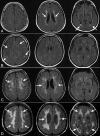Brain MR Imaging Findings in Woodhouse-Sakati Syndrome
- PMID: 30409855
- PMCID: PMC7655421
- DOI: 10.3174/ajnr.A5879
Brain MR Imaging Findings in Woodhouse-Sakati Syndrome
Abstract
Background and purpose: Woodhouse-Sakati syndrome is a rare autosomal recessive disorder characterized by hypogonadism, alopecia, diabetes mellitus, and progressive extrapyramidal signs. The disease is caused by biallelic pathogenic variants in the DCAF17 gene. The purpose of this study was to describe the spectrum of brain MR imaging abnormalities in Woodhouse-Sakati syndrome.
Materials and methods: We reviewed brain MR images of 26 patients with a clinical and genetic diagnosis of Woodhouse-Sakati syndrome (12 males, 14 females; age range, 16-45 years; mean age, 26.6 years). Follow-up studies were conducted for 6 patients.
Results: All patients had abnormal MR imaging findings. The most common abnormalities were a small pituitary gland (76.9%), pronounced basal ganglia iron deposition (73%), and white matter lesions in 69.2%. White matter lesions showed frontoparietal and periventricular predominance. All white matter lesions spared subcortical U-fibers and were nonenhanced. Prominent perivascular spaces (15.3%) and restricted diffusion in the splenium of the corpus callosum (7.6%) were less frequent findings. Follow-up studies showed expansion of white matter lesions with iron deposition further involving the red nucleus and substantia nigra. Older age was associated with a more severe degree of white matter lesions (P < .001).
Conclusions: Small pituitary gland, accentuated iron deposition in the globus pallidus, and nonenhancing frontoparietal/periventricular white matter lesions were the most noted abnormalities seen in our cohort. The pattern and extent of these findings were observed to correlate with older age, reflecting a possible progressive myelin destruction and/or axonal loss. The presence of pituitary hypoplasia and white matter lesions can further distinguish Woodhouse-Sakati syndrome from other neurodegenerative diseases with brain iron accumulation subtypes.
© 2018 by American Journal of Neuroradiology.
Figures






Similar articles
-
Woodhouse-Sakati Syndrome: First report of a Portuguese case.Am J Med Genet A. 2019 Nov;179(11):2237-2240. doi: 10.1002/ajmg.a.61303. Epub 2019 Jul 26. Am J Med Genet A. 2019. PMID: 31347785
-
A case of Woodhouse-Sakati syndrome with pituitary iron deposition, cardiac and intestinal anomalies, with a novel mutation in DCAF17.Eur J Med Genet. 2019 Aug;62(8):103687. doi: 10.1016/j.ejmg.2019.103687. Epub 2019 May 29. Eur J Med Genet. 2019. PMID: 31152917
-
Novel splicing-site mutation in DCAF17 gene causing Woodhouse-Sakati syndrome in a large consanguineous family.J Clin Lab Anal. 2022 Jan;36(1):e24127. doi: 10.1002/jcla.24127. Epub 2021 Dec 8. J Clin Lab Anal. 2022. PMID: 34877714 Free PMC article.
-
A novel DCAF17 homozygous mutation in a girl with Woodhouse-Sakati syndrome and review of the current literature.J Pediatr Endocrinol Metab. 2019 Nov 26;32(11):1287-1293. doi: 10.1515/jpem-2019-0173. J Pediatr Endocrinol Metab. 2019. PMID: 31472064 Review.
-
A diagnostic approach for neurodegeneration with brain iron accumulation: clinical features, genetics and brain imaging.Arq Neuropsiquiatr. 2016 Jul;74(7):587-96. doi: 10.1590/0004-282X20160080. Arq Neuropsiquiatr. 2016. PMID: 27487380 Review.
Cited by
-
Woodhouse-Sakati Syndrome Presenting With Psychotic Features After Starting Trihexyphenidyl: A Case Report.Cureus. 2022 Aug 1;14(8):e27576. doi: 10.7759/cureus.27576. eCollection 2022 Aug. Cureus. 2022. PMID: 36059322 Free PMC article.
-
Nine Hereditary Movement Disorders First Described in Asia: Their History and Evolution.J Mov Disord. 2023 Sep;16(3):231-247. doi: 10.14802/jmd.23065. Epub 2023 Jun 13. J Mov Disord. 2023. PMID: 37309109 Free PMC article.
-
Woodhouse-Sakati syndrome (WSS): A case report of 3 Saudi sisters with urogenital anomalies.Saudi Med J. 2021 Nov;42(11):1237-1242. doi: 10.15537/smj.2021.42.11.20210329. Saudi Med J. 2021. PMID: 34732557 Free PMC article.
-
Movement Disorders Associated with Hypogonadism.Mov Disord Clin Pract. 2021 Jul 29;8(7):997-1011. doi: 10.1002/mdc3.13308. eCollection 2021 Oct. Mov Disord Clin Pract. 2021. PMID: 34631935 Free PMC article. Review.
-
Woodhouse-sakati syndrome with no reportable MRI findings: a case report.BMC Neurol. 2024 Sep 28;24(1):359. doi: 10.1186/s12883-024-03865-z. BMC Neurol. 2024. PMID: 39342163 Free PMC article.
References
-
- Bohlega SA, Alkuraya FS. Woodhouse-Sakati syndrome. 2016. August 4 In: Adam MP, Ardinger HH, Pagon RA, et al., eds. GeneReviews. https://www.ncbi.nlm.nih.gov/books/NBK378974/. Accessed May 16, 2018.
-
- Al-Semari A, Bohlega S. Autosomal-recessive syndrome with alopecia, hypogonadism, progressive extra-pyramidal disorder, white matter disease, sensory neural deafness, diabetes mellitus, and low IGF1. Am J Med Genet Part A 2007;143A:149–160 - PubMed
MeSH terms
Supplementary concepts
LinkOut - more resources
Full Text Sources
Medical
